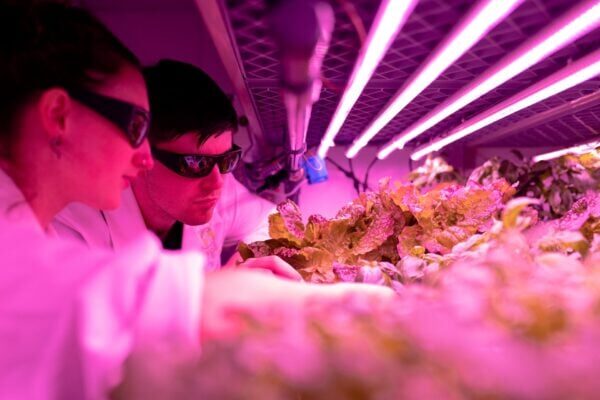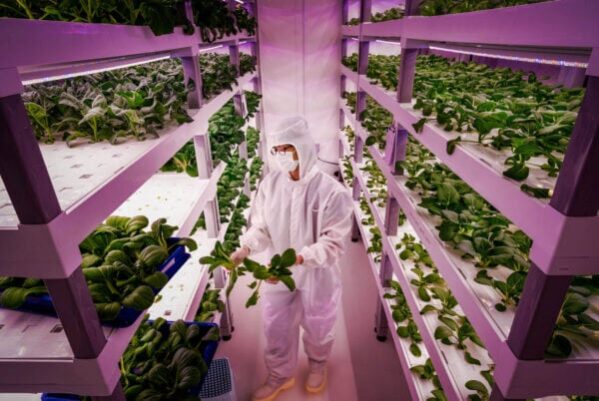
At the end of 2022, the UN counted 8 billion humans on the planet, and this number is climbing. Given this situation, the question we have to ask is, “How are we going to feed the world’s population?” Agriculture in controlled environments, also called ‘indoor cultivation,’ holds some of the keys to the future of human food: high-tech infrastructures to cultivate all kinds of vegetables and fruits.
What does indoor agriculture entail?
In essence, indoor farming consists of growing crops inside buildings using advanced technology systems such as hydroponics (nutrient solutions instead of soil), aeroponics (roots are sprayed with water mist), or aquaponics (a combination of aquaculture and hydroponics). And many, many LED lights.
The most common images of agriculture crops in controlled environments are large hangars in semi-twilight or purple-pink light, with high shelves up to the ceiling filled with lettuce and staff in lab coats. In the photo, a farmer picks lettuce in Singapore. Why are these environments purple? Why does the farmer look like a laboratory researcher?
High-tech agriculture
Agriculture in controlled environments should be understood to be “high-tech agriculture” that is also, in theory, high efficiency. At least, that’s the long-term goal; we’re still in an accelerated phase of development. You have to imagine these major infrastructures like factories, assembly lines, or industrialized processes: this will be a linear process until the plant is developed, even though this ‘food factory’ will be part of the circular economy.
Unlike outdoor farming, which is subject to environmental chaos that’s often not predictable (diseases, pests, weather), indoor vertical farming is a type of cultivation that’s characterized by predictability. The managers of these infrastructures know metrics such as water flows, energy consumed, production volume, losses, and so on at all times.
It’s not that indoor agriculture has been highly modernized; it started out modernized, much like how electric cars are digital by design. Moreover, this type of crop can use local inputs such as organic matter, sunlight, and water from the watershed where the produce will be consumed.
Purple farms, the engineering rationale behind the color of agriculture in controlled environments
Plants need several elements to grow and develop. Water, nutrients, and light are the most important, followed by others like temperature. At these ‘food factories,’ vegetation receives the exact elements it needs for growth, no more and no less, without wasting a drop of water or a kWh of energy.
When you see areas lit in purple or pink at these farms, you are actually seeing the effect of illumination with blue and red LEDs, leaving out the green part of the spectrum since green plants don’t absorb these frequencies. Why waste energy on emitting light that doesn’t do anything? It’s all a matter of using technology for energy savings.
Fields on fields: high-altitude engineering to take up less space
One of the challenges of traditional farming is its dependence on fossil energy and its impact on the environment due to using vast areas of land. Indoor cultivation technology solves this by creating ‘fields’ at different heights by stacking levels on top of each other.
Thanks to a type of engineering that’s well-established (vertical warehouses), it’s possible to reach 1:10 crop ratios, climbing to ten stories and maximizing the land use. The FAO estimates that each person needs about 0.20 hectares for their food (about 2,000 m2). This technology would make it possible to reduce that amount to 200 m2 through vertical cultivation – that’s a 14×14 meter square and ten floors.
This technology does not require pesticides, insecticides, or herbicides
One of the advantages of controlled environment crops is precisely the environmental control that’s possible. While they will always be susceptible to human errors that introduce pathogens (why workers are dressed like they are), the truth is, this is cleaner than the traditional alternatives because pests can’t thrive inside.
By eliminating the need for inputs like pesticides, herbicides, or insecticides, as well as all the negative impacts associated with these compounds, these crops are more sustainable in this regard, and they also ensure a regular production volume. As previously mentioned, it has to be seen more as a food factory than as cultivation as it was done in centuries past.
The exact nutrients the plant needs: new agricultural engineering

But a key point of this whole growth cycle is the way nitrogen is used, a key element in the development of plants that often acts as a bottleneck. In open-air fields, it’s common to fertilize crops with very expensive synthetic fertilizers that have a high environmental impact and are inefficient, and their waste pollutes the environment.
This indoor infrastructure for cultivation also includes synthetic nitrogen, but on a much smaller scale, and it is fully utilized. Nitrogen circulates within a closed circuit of nutrients, and, just like the electrical energy for the LEDs, the exact amount needed is supplied without any waste. This prevents wasting resources or polluting natural areas.
Crop technology against food waste
When cultivation is moved from the field into a highly modernized infrastructure, one of the immediate results is a drastic reduction of food waste by preventing adverse weather events, such as heat waves and hurricanes, eliminating pests, preventing a lack of workers at specific times, etc. The crop becomes predictable and more productive, as well as invulnerable to events like frost.

This is so much the case that it’s possible to work with crops on demand, cultivating only what will be consumed, versus the classic model of producing as much as possible in the hope that it will be bought. This is one of the greatest contributions engineering has made to the field through optimized systems such as farms inside hangars. But it’s not all pluses.
Agriculture in controlled environments still needs more development
Agriculture in controlled environments is a relatively new form of cultivation still in development. For example, the cycle of lettuces and green leafy plants is so optimized that it’s already much more efficient to grow indoors, but this is because these types of plants are simple compared to others.
One of the challenges of this type of agriculture is electrification. While it does usually use less gross energy in the end than outdoor cultivation, indoor agriculture actually needs electrical energy rather than mechanical or chemical sources (available from petroleum derivatives). So this leap from the field to the indoors takes more efficiency in renewable electric energy.
Lastly, this technology is not a panacea, nor will it be implemented all over the world in the same way. New studies have shown that the leading technology almost everywhere around the world is still greenhouses, over outdoor fields, leaving agriculture in controlled environments as optimal only in places with unfavorable environmental conditions.
This all seems to suggest that indoor cultivation technology would be a huge support for feeding the world at a low cost and with a low environmental impact. It will address other environmental problems and electrify the food production sector, bringing food sources closer to where they are consumed.






There are no comments yet